|
January 1960 Electronics World
 Table of Contents
Table of Contents
Wax nostalgic about and learn from the history of early electronics. See articles
from
Electronics World, published May 1959
- December 1971. All copyrights hereby acknowledged.
|
This "Recent Developments
in Electronics" from a 1960 issue of Electronics World had a lot of antenna
news that included a retarded surface wave antenna with high gain and low silhouette
for use in airborne early warning radar as well as ground based and shipboard radar,
a pair of 60-foot tropospheric scatter antennas that are specially mounted at opposite
ends of a 180-mile long section of the Gulf of Mexico, and a 104-foot-long rotating
50-ton radar antenna used for the SAGE early warning system. Also reported was Westinghouse
Electric's airborne Stratovision for broadcasting educational television programming
to rural areas out of reach of existing towers. Stratovision had been around for
more than a decade given that an article entitled "Is
Stratovision the Answer?" had been published in a 1950 Radio & Television
News magazine, describing the modified
B-29 Superfortress airframe.
See "Is
Stratovision the Answer?," January 1950 Radio & Television News; "Stratovision
Goes Educational," January 1960 Electronics World; "Stratovision,"
October 1945 Radio-Craft, and even a Carl & Jerry adventure entitled "Pi
in the Sky and Big Twist," February 1964 Popular Electronics. Also
see the article titled "MPATI - Its Problems & Solutions," in the May 1963 issue of
Radio & Television News magazine.
Recent Developments in Electronics
Aluminum Music Sphere
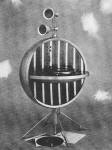 From the world of tomorrow comes this "Forecast
Music Sphere," created by Lester Beall for the Aluminum Company of America. The
novel enclosure houses a stereo music system with extending satellite speakers which
telescope into the aluminum body shell. The front hemisphere is opened to reveal
turntable and amplifier controls. The prototype design represents a design concept.
It is not on the market, and there are no immediate plans to place it in production. From the world of tomorrow comes this "Forecast
Music Sphere," created by Lester Beall for the Aluminum Company of America. The
novel enclosure houses a stereo music system with extending satellite speakers which
telescope into the aluminum body shell. The front hemisphere is opened to reveal
turntable and amplifier controls. The prototype design represents a design concept.
It is not on the market, and there are no immediate plans to place it in production.
Stratovision Goes Educational
 Pictured is the experimental Westinghouse
Stratovision station which first demonstrated the feasibility of airborne telecasting
- a technique that will be utilized by the Midwest Council on Airborne Television
Instruction to make available instructional television programs over a six-state
area. Programs will be transmitted from ground-based facilities at Purdue University
in Lafayette, Ind. to the circling four-engine aircraft some distance away. Re-telecast
will take place from the plane to schools and colleges which choose to participate
in the project. Estimated coverage will be a circle 300-400 miles in diameter, reaching
from Milwaukee and Detroit to Cincinnati and Louisville. Pictured is the experimental Westinghouse
Stratovision station which first demonstrated the feasibility of airborne telecasting
- a technique that will be utilized by the Midwest Council on Airborne Television
Instruction to make available instructional television programs over a six-state
area. Programs will be transmitted from ground-based facilities at Purdue University
in Lafayette, Ind. to the circling four-engine aircraft some distance away. Re-telecast
will take place from the plane to schools and colleges which choose to participate
in the project. Estimated coverage will be a circle 300-400 miles in diameter, reaching
from Milwaukee and Detroit to Cincinnati and Louisville.
Retarded Surface Wave Antenna
 A retarded surface wave antenna with high
gain and low silhouette has been developed by Chance Vought Electronics Division
for use in airborne early warning radar as well as ground based and shipboard radar.
Initial tests showed such good performance characteristics that the company devoted
additional efforts to perfecting the design. Most airborne radar antennas are so
large in diameter and thickness that they present aerodynamic and weight problems
for the aircraft designer. A 33-foot retarded surface wave antenna would be only
1 1/2 feet in thickness and weigh 2400 pounds, compared to 8 feet and 5030 pounds
for a parabola-type antenna. At the same time the new antenna would equal or exceed
a conventional antenna in electrical performance. The design is adaptable to various
sizes and configurations. A retarded surface wave antenna with high
gain and low silhouette has been developed by Chance Vought Electronics Division
for use in airborne early warning radar as well as ground based and shipboard radar.
Initial tests showed such good performance characteristics that the company devoted
additional efforts to perfecting the design. Most airborne radar antennas are so
large in diameter and thickness that they present aerodynamic and weight problems
for the aircraft designer. A 33-foot retarded surface wave antenna would be only
1 1/2 feet in thickness and weigh 2400 pounds, compared to 8 feet and 5030 pounds
for a parabola-type antenna. At the same time the new antenna would equal or exceed
a conventional antenna in electrical performance. The design is adaptable to various
sizes and configurations.
Twin Tropo Scatter Antennas
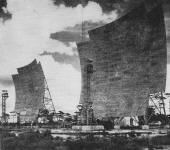 A pair of 60-foot tropospheric scatter antennas,
specially mounted at opposite ends of a 180-mile long section of the Gulf of Mexico,
form a vital link in a new communications network built for the U. S. Air Force's
Eglin Gulf Test Range. Built at a cost of $6-million, the entire 565-mile long network
is being used for high-speed transmission of timing, telemetering, radar data, and
voice signal information along the missile range. The antennas were built by Blaw-Knox
Co. and erected by Philco Corp. A pair of 60-foot tropospheric scatter antennas,
specially mounted at opposite ends of a 180-mile long section of the Gulf of Mexico,
form a vital link in a new communications network built for the U. S. Air Force's
Eglin Gulf Test Range. Built at a cost of $6-million, the entire 565-mile long network
is being used for high-speed transmission of timing, telemetering, radar data, and
voice signal information along the missile range. The antennas were built by Blaw-Knox
Co. and erected by Philco Corp.
Boxcar-Shaped Radar Antenna
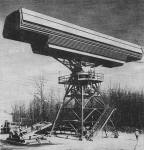 A rotating 50-ton radar antenna, 104 feet
long, will warn against enemy air attack when it joins the nation's SAGE defense
network in the near future. Developed for the Air Force by Raytheon Co. under a
$20-million engineering program, the super sentry will detect invaders hundreds
of miles away to give early warning. A rotating 50-ton radar antenna, 104 feet
long, will warn against enemy air attack when it joins the nation's SAGE defense
network in the near future. Developed for the Air Force by Raytheon Co. under a
$20-million engineering program, the super sentry will detect invaders hundreds
of miles away to give early warning.
A Ticker-Tape TV
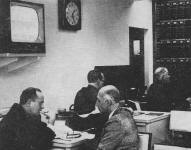 At the modern new offices of Goodbody &
Co., New York City, a network of strategically located closed-circuit TV receivers
flashes pictures of stock ticker tapes to customers, partners, and employees in
all executive and sales areas. The TV equipment, designed by General Precision Laboratory
Inc., enables the firm to provide faster and more efficient service for clients. At the modern new offices of Goodbody &
Co., New York City, a network of strategically located closed-circuit TV receivers
flashes pictures of stock ticker tapes to customers, partners, and employees in
all executive and sales areas. The TV equipment, designed by General Precision Laboratory
Inc., enables the firm to provide faster and more efficient service for clients.
Automatic Testing of TV Picture Tubes
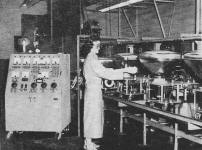 Latest innovation in the manufacture of
black-and-white television picture tubes is a new automatic testing machine which
has been installed at the RCA Electron Tube Division's plant in Marion, Ind. This
precision instrument performs 26 different tests on the tubes at a rate of 600 per
hour. Latest innovation in the manufacture of
black-and-white television picture tubes is a new automatic testing machine which
has been installed at the RCA Electron Tube Division's plant in Marion, Ind. This
precision instrument performs 26 different tests on the tubes at a rate of 600 per
hour.
Posted May 21, 2019
|
















